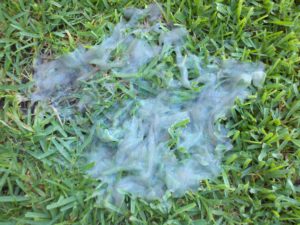 Is your air conditioners condensate drain line clogged? Here we will discuss some of the symptoms of this problem and how to fix them. This is put into the category of Hvac for Beginners. I normally don’t promote diy hvac repairs. But cleaning your air conditioners condensate drain line can usually be done by the homeowner in most cases.
Is your air conditioners condensate drain line clogged? Here we will discuss some of the symptoms of this problem and how to fix them. This is put into the category of Hvac for Beginners. I normally don’t promote diy hvac repairs. But cleaning your air conditioners condensate drain line can usually be done by the homeowner in most cases.
Where is the Condensate Drain Line Located?
Your air conditioners condensate drain line is located where the air handler is. In residential installations the condensate will usually be pvc or cpvc. Commercial applications may use copper as drain lines. The drain line is then ran either into a floor drain or outside of the home.
If the drain line is ran outside it is usually located next to the condensing unit. This is not always the case though. Some common areas in homes where the air handler is installed are attics (dumb), garages, basements and closets.
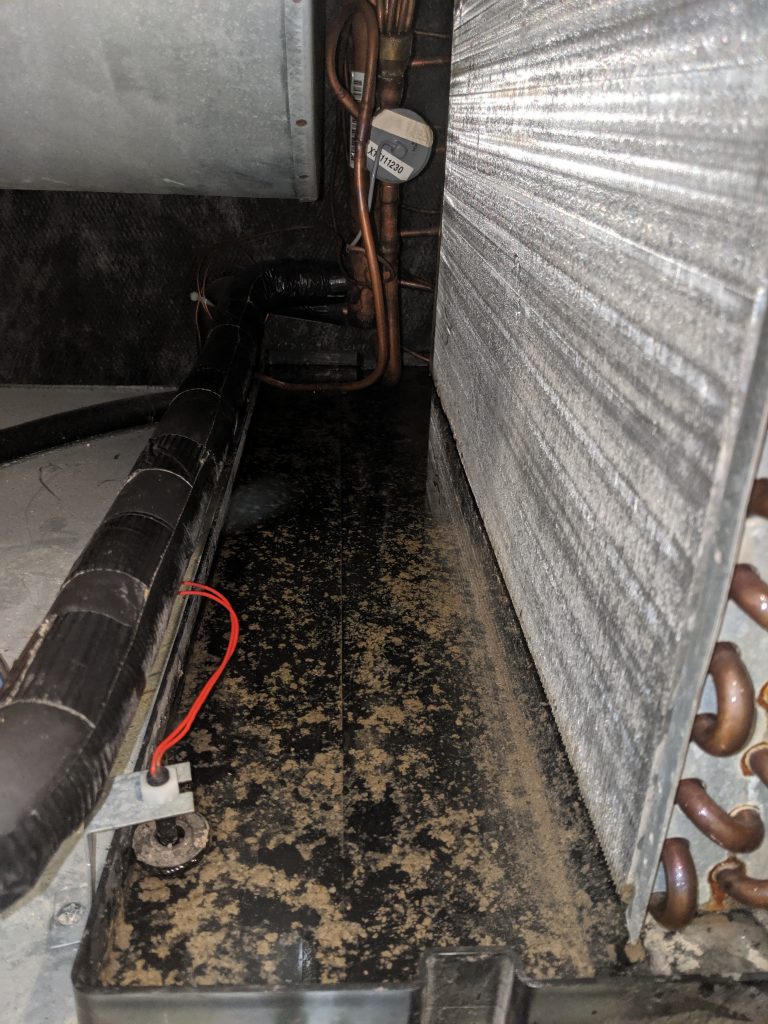
Can I Use Bleach to Clean my Condensate Drain Line?
First things first. Let’s go over how NOT to clean your condensate drain line. Stop using bleach. Unless you are absolutely sure there is no way that the bleach can get back into the air handlers drain pan, don’t use it. Even then the fumes could potentially damage the coils. Don’t believe me? Here is a screen shot of a Rheem installation manual on the maintenance part of the air handler, particularly the drain cleaning part.
If you want to risk damaging your equipment, then by all means keep using bleach. If you want some other options of cleaning the drain out properly then keep reading.
How do I unclog my air conditioner drain pipe?
Here is a picture of a properly piped air handler for draining purposes.
If yours is one that has a drain clean out cap, and a vent, then this is usually can be cleaned with something as simple as a drain cleaning brush and hot water. Back when I was doing maintenance on the regular though I like to use my wet/vac with a combination of pouring how water in the air handlers drain pan itself. Note that if you have a vent pipe like in the picture above that you will need to cover that vent when using a vacuum. A small rag or old t-shirt should do the trick.
When choosing a wet vacuum to clean your ac drain keep in mind that the horse power rating is more important than the gallon capacity. This is assuming that you will be primarily using this for small jobs as well.
When I was in the service field and had to do routine maintenance on air conditioners this is how I would clear drain lines. Hook up the wet vacuum to where ever the drain line ends, and make sure the connection is tight so you get maximum suction. I would us a pvc coupling at the end of my hose so I could just hook it up to the drain line.
I would then turn the vacuum on, then go to the air handler and pour hot water down the drain line, either from the clean out cap, or better yet the air handler drain pan itself. Note that you should also be able to here the vacuum ‘sucking’ when you are at the drain line by the air handler. If you don’t, you either still have a clogged drain line, or you are on the wrong pipe outside.
A few minutes of running the wet dry vacuum should do the trick.
What Causes Condensate Drain Lines to Get Clogged?
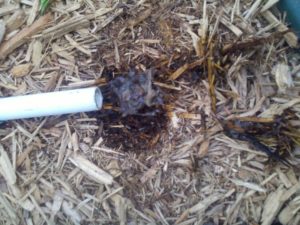 It’s usually a form of algae. As the warm air is brought across the cold evaporator coil, it creates condensate. The condensate is constantly traveling through the humid drain piping where algae loves to grow. In my hvac career I have seen some pretty nasty stuff that I’ve pulled out of air conditioning condensate drain lines.
It’s usually a form of algae. As the warm air is brought across the cold evaporator coil, it creates condensate. The condensate is constantly traveling through the humid drain piping where algae loves to grow. In my hvac career I have seen some pretty nasty stuff that I’ve pulled out of air conditioning condensate drain lines.
Air conditioning units that get a lot of work and are constantly running are going to get clogged more often. This is especially true in humid environments. This is even more true on air conditioning systems that don’t have regular maintenance. Here are a couple of pictures of some extreme algae build up that I’ve gotten out of condensate drain lines.
Other Methods to clean a clogged a/c condensate drain line
- If you can located the end of the drain line, then sometimes you may be able to use a garden hose to break up the clog. I recommend using a nozzle on the garden hose, and slowly apply water pressure into the drain pipe. Small short bursts should be enough to break up the clog. From there I would pour some hot water down the drain at the air handler. If you can use the garden hose to flush the drain pipe from the inside out, you can try that as well until the water is flowing freely.
- Using compressed air. If you have a small portable air compressor this may be another option for the homeowner to clear their condensate line. I’ve used nitrogen myself before in some extreme conditions. But I would not recommend it as you can seriously injure or even kill yourself if you don’t have, or don’t know how to use a nitrogen regulator.
- Small hand snake or drain cleaning brush. If the clog is located right at the trap, most of the time it can be pushed through with a drain cleaning brush. If the clog is further down the line, a small hand snake may be an option, depending on how well it can turn the 90 degree bends.
Preventing Clogged A/C Condensate Drain Lines
Get a maintenance plan with a local reputable Hvac company. Make sure that they offer condensate drain cleaning. This is the easiest way as there is very little to do on your part.
If you are a DIY type of person then using the shop vac method a couple times a year will help keep your condensate drain line flowing freely year round. It is much easier to clean a line that isn’t fully clogged, rather than waiting until it does get clogged.
There are also a variety of algae tabs that are specifically made to prevent the growth of algae in your a/c drain line. I have tried SEVERAL of these tablets. You just put a couple of them in the drain pan once or twice a year, and they are suppose to prevent algae growth. While some may help, I’ve never seen one that could completely eliminate the problem. They do help control odors inside of the air handler though. That’s a plus.
Clogged A/C Drain Symptoms
Here are some symptoms that you may have if your a/c condensate drain line is clogged. Depending on your installation set up these may vary.
1. Water flooding around the air handler unit, dripping into the secondary pan. Depending on local codes, most air conditioning units need to have some type of water safety switch. The water safety switch will help prevent your home from being flooded due to a clogged condensate drain line.
Although this is a symptom of a clogged drain line, it is not 100%. Other things that could cause water build up around your air handler are frozen coils, cracked drain pans, or improper installation.
2. Unit won’t cool/run. If your unit won’t cool due to a clogged drain line, it is going to trigger the water safety switch. Sometimes these will be hooked up to break the ‘Y’ wire, which will just shut down your compressor, while others may break the “R” wire, which will break the low voltage at the air handler. If you know where your air handler and water switch are you can usually check this pretty easily to see if there’s water at the safety switch.
Overall keeping your a/c condensate drain line flowing freely can be done without technical hvac training in most cases.
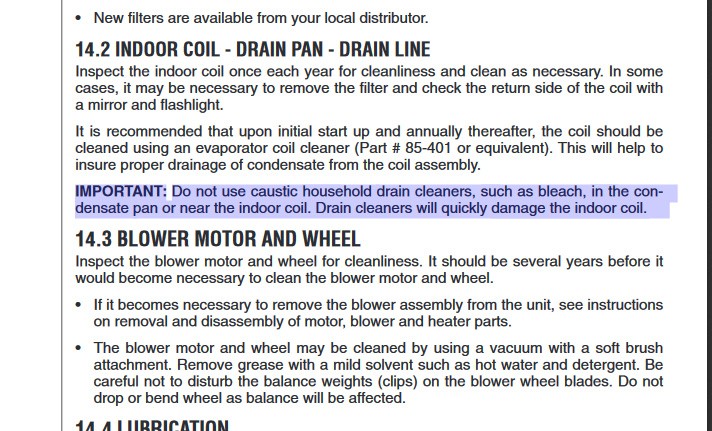
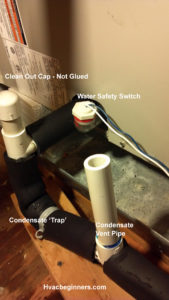
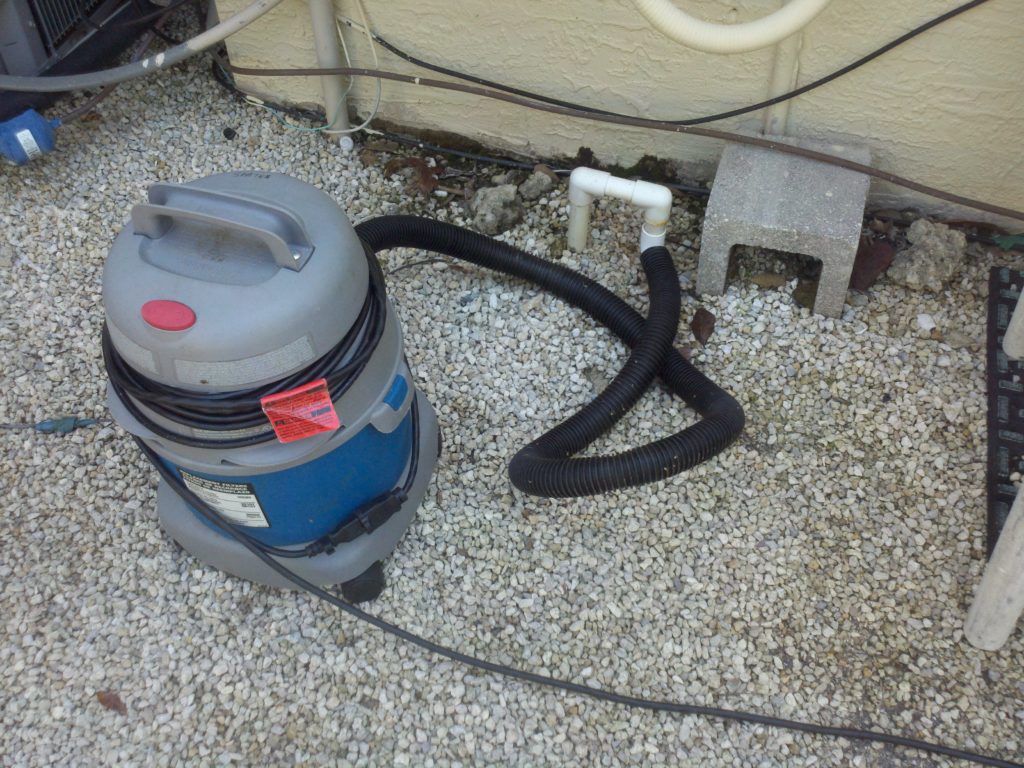
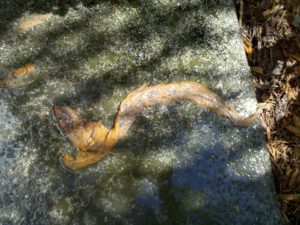
It’s not usually the drain line that is clogged but the p-trap on the line. With the way the p-trap is designed it is a bug in the system and p-traps eventually clog. P-traps are a flawed,120 year old device that has several problems. P-traps can also freeze, and when they freeze they crack and lose their prime. Then you have blow-back inside the unit. Replace the p-trap with a V-trap from vtraps.com and you can eliminate the clogging that p-traps need. V-traps are self-cleaning, self-priming, non-freezing and self-sealing.
Be sure to pour some water into the pan so the p-trap is refilled when you are done cleaning the p-trap. If you don’t there will be blow-back and you’ll have water leaking onto the floor around the unit. You’ll think you didn’t get the drain cleaned out, but this is a totally different problem.